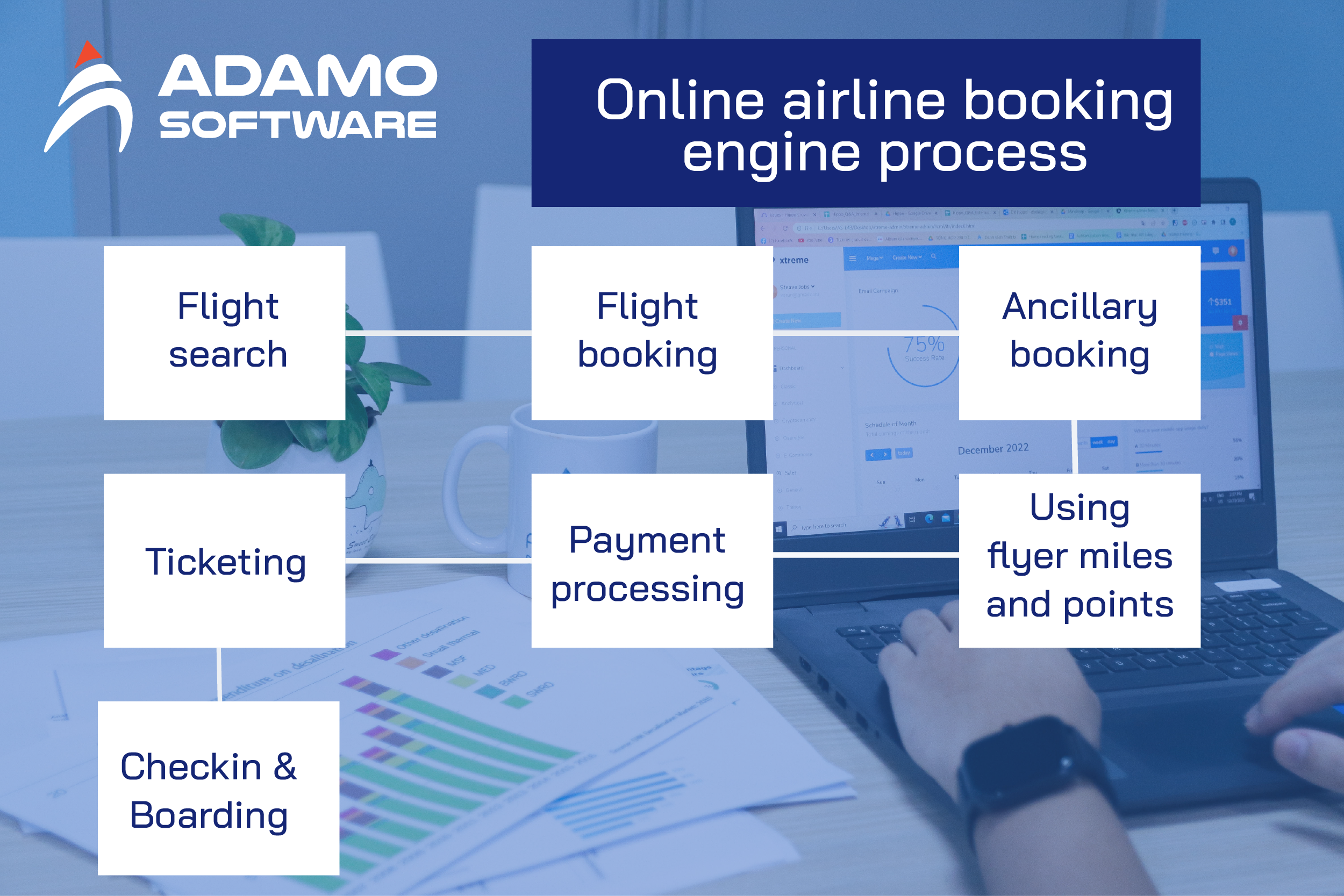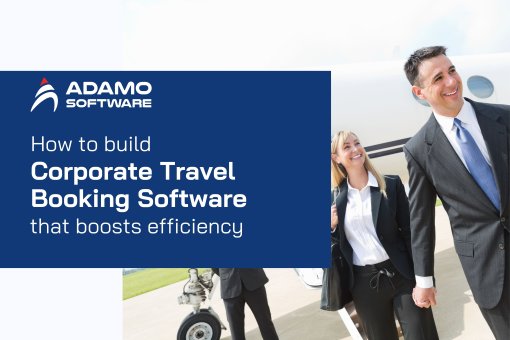Flight booking engine: explore solution to manage flight bookings

An efficient Flight Booking Engine is critical for the airline industry to better management and consistency in its operations to fulfill every possible need.
Travel statistics show that business travel brings in more than 28% of all travel and tourism income. Business travel is important for many companies that want to grow, whether it’s to meet new clients and network in their own country or around the world.
Every business, no matter how big or small, needs to make sure their business travel is as efficient as it can be. It’s not easy to fly workers around the world, and companies need to be able to use Flight Booking Engine and other solutions quickly.
I, Flight booking engine definition
A flight booking engine is a web-based flight reservation software system that enables end users to search for and purchase airline/flight tickets. It enables users to search for global destinations, make reservations, and generate PNRs via online payments. In the same flight booking search engine, the best flight booking engine also permits passengers to submit quotation for flight rates and manage customer requests.
The flight booking engine is designed specifically for travel agencies to facilitate the booking process. Furthermore, it provides a unified platform for their clients to reserve one-way, round-trip, and multi-destination flights.
By automating the airline reservation procedure, the Flight Booking Engine contributes to increased revenue. Its purpose is to facilitate the purchasing process for clients of online travel agencies by allowing them to search for and book flight tickets in real-time. Users can choose their desired seat and remain informed regarding the progress of their reservation.
II, What are airline reservation system benefits?
The flight booking engine facilitates the expansion of travel agents’ enterprises by enlisting a greater number of clients. A flight booking engine permits clients access to an extensive database, making it an ideal platform for reserving tours, flights, dynamic packages, and various travel-related activities. Benefiting from many flight reservations daily, it is an effective solution for both B2B and B2C channels.
The airline reservation system has useful tools for travel companies, travel agents, tour operators, TMCs, and other travel service providers.
The flight booking engine is known to be the most vital component of the travel reservation software. It has directly contributed to the growth of travel companies’ revenue over the years.
III, Explore GDS systems role in flight booking engine
The airline industry has changed the implementation of the Global Distribution System (GDS). Effective online systems for booking travel, such as flight booking engines, rely on the inventory and the markup. GDS systems give end users a single way to reach the best inventory, which means they can get better deals.
These days, global travel companies won’t be happy until they can add a flight booking engine to their website. Thanks to the GDS of airlines, travel agencies can reach customers all over the world. It does this by connecting hundreds of airlines with a big network of travel agents.
This means that travel companies whose B2B and B2C platforms integrate GDS can have a full flight booking engine and can start taking bookings from all over the world in one place.
IV, Online airline booking engines process: key steps

1. Flight search
Currently, travelers seeking to book a flight can find flights directly from airline websites or via indirect channels – OTAs (Online Travel Agencies), like Expedia, Orbitz, Travelocity, or Priceline or metasearch engines like Kayak or Skyscanner. The technology and results of the search process will be a little different depending on the type of retailer.
1.1. Via airline website
The website skips the whole GDS process and sends a search request straight to the airline’s CRS. It then shows the user a list of all the flights that are available.
Still, most of the time, travelers want to check prices between airlines or need to book a complicated route that works with more than one airline. Obviously, they will choose third-party sites that collect relevant offers from different sources for a passenger’s query.
1.2. Via OTAs
Online travel agencies get details about flights from:
– GDSs
– Air consolidators
– Partner airlines.
To optimize revenue, travel platforms use smart flight booking engines and sort and display airfare deals based on predefined pricing and business rules.
1.3. Via metasearch engines
Metasearch engines search OTAs, full-service carriers, and low-cost airlines (LCCs) that don’t use GDSs for bargains. Visitors will obtain the broadest range of market-available flights.
One bad thing about a traditional metasearch engine is that it doesn’t let you book things. Instead, it sends travelers to a partner site where they can take the next step that makes sense.
2. Flight booking
When it comes to searching, OTAs and metasearch engines are the best options. But when it comes to booking, most tourists go to airline websites. This is mostly because of two things.
Firstly, if you buy seats directly from the airline, it will be easier to make changes to your ticket or cancel the flight, even from a technical point of view. Second, tourists can choose from more add-ons than most OTAs offer.
Airline CRS (Central Reservation System) has to check if the flight product in question is still available for reservation, no matter where the ticket came from. Then, it sends a reply message to the ticket agent with the status code HK, which means “holding confirmed.” The other possible answer is the UN, which means the airline can’t meet the needs.
At this point, the CRS also needs to make a PNR (Passenger Name Record). At the time of booking, a retailer, like an OTA or airline website, gets personal information from the customer, like their name and contact information, and sends it to the CRS. After getting all the necessary information, the system creates a PNR number that contains the file’s computer address in the database.
3. Ancillary booking
Ancillary booking is still a big part of how airlines make money, especially low-cost carriers. On the list of extra services are seat selection, extra legroom, extra baggage space, and meals during the trip.
When booking a flight, a traveler usually picks extras. However, if you buy the flight straight from the airline, you can add extras later. Using the PNR number, passengers can go to the airline’s website, find their reservations, and make changes to them.
4. Using frequent flyer miles and points
Members of a frequent-flyer or airline loyalty program can utilize earned miles or points from past flights to purchase additional airline services. These points can be exchanged for discounts or privileges, such as an upgrade to business class. CRSs allocate a certain number of seats for frequent flyers in order to earn consumer loyalty.
Passengers can log in using their accounts while purchasing tickets from an airline’s website. Moreover, they can obtain a loyalty program participant’s number to book from a third-party.
5. Payment processing
To fly, you need to have money to back up your plans. This means that people who want to use a seat have to pay the fare plus taxes and any extra costs.
Passengers and low-cost airlines can handle their money transactions through payment platforms, which are third-party services that handle transactions and keep data safe.
After making the payment, the traveler gets an email with their trip itinerary and PNR number. That is enough to check on the flight, cancel the trip, or even change the future trip and add extras if you booked it directly. However, people need tickets to get on the plane.
6. Ticketing
Getting tickets and making reservations are two different things. It only holds the place on the plane. If someone buys a ticket, that means they have the right to sit in that seat during the trip. You must wait a while between these steps, even if you pay for the trip right away, which is what most OTAs and LCCs require. Usually, it takes up to three business days to confirm payment information and send the money.
The above-mentioned BSP and ARC must certify the company before it can issue an e-ticket or individual electronic receipts related to the PNR. Not every store that sells plane tickets can afford this. Instead, they book flights through authorized partners, such as large online travel agencies, air consolidators, or host travel agents.
What if your trip includes more than one flight with a different airline? There is a special deal between carriers called “interlining” that lets them cover all parts of the schedule on a single ticket. It’s also possible to connect different parts of a trip into a single Super PNR record.
Finally, the visitor gets an email with their e-ticket, which has their name and the PNR number. If the reservation can’t be confirmed for some reason, the travel company must either offer a different flight or give a full return.
7. Check-in and boarding
7.1. Online check-in
It depends on the airline, but online check-in is usually possible 48 hours before the trip. When a tourist enters information from an e-ticket on an airline’s website or app, they can see a map of their seats on the plane and choose one. If a person doesn’t choose it, the system gives them an electronic boarding pass and picks a free one at random. The idea behind check-in machines is the same.
7.2. Airport check-in
In this case, a person brings an e-ticket to the airport agent at the check-in desk to enter details and book a seat on a seat map.
7.3. Baggage handling and reclaim
Unless a passenger loses their luggage, a plane’s landing marks the end of a voyage. The airline’s DCS prints bag tags with ten-digit numeric codes, often known as barcodes, to avoid this. The airport’s baggage system reads barcodes to categorize and track luggage.
The codes also appear in IATA’s WorldTracer baggage tracking system. By inputting their last name and the baggage’s ten-digit code, passengers can check their luggage status.
V, How does airline e-ticket work?
Seeing worried flying customers digging anxiously through their belongings for a slick ticket has become unusual at airports recently. This is because more people rely on e-tickets when flying. An e-ticket contains the same information as a paper ticket.
The main distinction is that an e-ticket is stored in an airline’s computer database rather than in the traveler’s bag. It is an electronic record of the traveler’s airline reservation that includes information such as the flight time, date, and location, air terminal, seat assignment, and travel class.
E-ticket holders only need to show a valid photograph identification proof card at the gate. upon the airline confirms the traveler’s information, it issues a ticket for the traveler to use upon boarding the plane.
Airlines must have a database that is integrated with their passenger services system in order to issue tickets. This is then linked to every other partner – airlines, airports, ground transportation, and travel agencies.
Travelers can buy flights through various internet ticketing websites. Once there, consumers can browse the various alternatives and pay for their tickets with a credit or debit card. After submitting the request, the electronic record of the ticket is stored in the passenger’s database, where it is assigned to the traveler.
E-tickets have pretty much taken the place of paper tickets at most airports and planes around the world. You can also explore about other online booking engines here.
VI, Best system for flight booking solutions
1. TravelPerk
TravelPerk is an all-inclusive travel solution that facilitates the efficient and effortless identification of optimal travel alternatives for organizations. Plus, TravelPerk’s relationships with over 26,000 airlines and specially negotiated rates ensure you get the best deal for your business travelers. All you have to do is download your e-ticket, check in, and buckle up.
2. SAP Concur
There are a lot of travel managers and people who book business trips for other workers who use SAP Concur. Finding the best deals can help you keep track of your spending and make your money go further with the amount you have.
With this software, you can get results that are on par with what you’d get from a tour agency. When it comes to using the tool, SAP Concur is better for the travel business in many ways than others.
3. Spendesk
Spendesk helps make business travel easier for the people in the company who are in charge of planning it. It helps you book, change, and keep track of all kinds of travel directly on the site. Besides that, it can also help keep track of staff costs and make reports automatically.
For buying flights, Spendesk works with some of the best companies to help you get the best deal for your peers and their budget. Spendesk is a flexible tool that can help you set up and book trips more quickly.
4. Flightslogic
Flightslogic is a great choice for travel managers who want to help employees have better experiences on business trips by managing the whole process.
Having everything in one place makes it easier for managers to keep track of and plan all of their employees’ travel.
5. SalesTrip
SalesTrip has many tools and services that make it easy and simple to book business trips.
You can find the best business travel choices with the help of automated trip searches. Using Salesforce data can give you choices for traveling both inside and outside of the United States. It’s quick to book travel because you can book planes, trains, rental cars, and hotels all at the same time.
VII, What Makes Adamo Become as a Premier Travel Software Development Company
Through a journey of working in the travel & hospitality industry, Adamo puts three factors at first including promptly to launch in the market, providing lucrative and innovative software solution, and helping clients to allocate human resources for their project properly. Moreover, Adamo has worked with lots of travel companies all over the world, thus we are confident to provide you with the best travel software solution that is custom for your business logics. You also can contact us to receive experts’ advice from other fields such as fintech, healthcare and media and entertainment as well. As a premier travel software company in Vietnam, explore more travel solutions related to booking engines.











